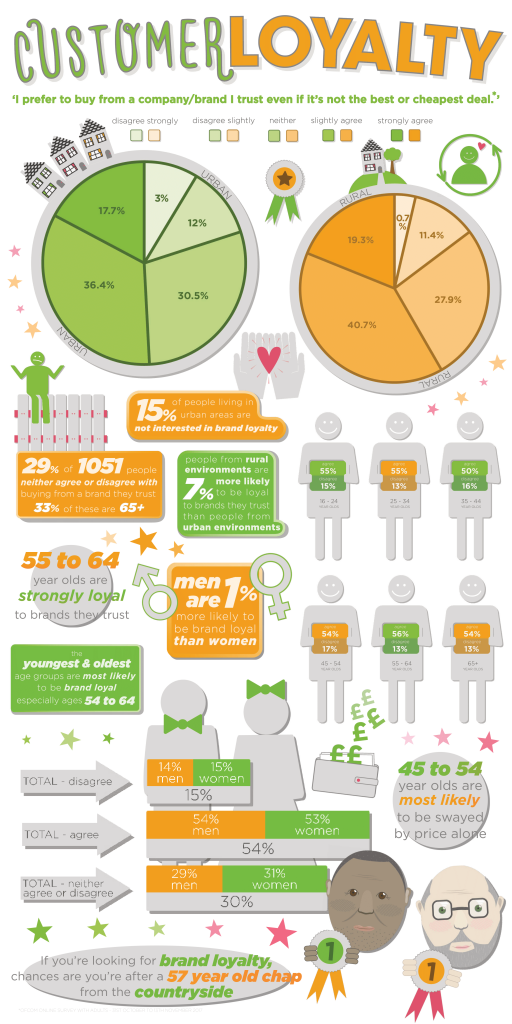Looking to reduce your customer churn?
Any successful marketing approach shouldn’t just attract new customers, it should also hang onto the customers you already have. To that end, customer loyalty schemes have grown in prominence and become near-universal in most business sectors. But could a loyalty scheme work for you? And, what other incentives can help cultivate that most elusive of things, customer loyalty?

Design By Lizzie Cole
The big L
Loyalty is a big word. It holds a weight of emotional and personal implications. How then, can a brand hope to illicit such strength of connection with its customers or client base? Many companies have tried, only some have succeeded.
Loyalty starts with you…
A loyalty scheme isn’t a one-stop shortcut to success. Any reward scheme needs to form part of your wider value proposition. It starts with what you are offering. Make sure your product, service and brand work together to create an effective customer experience. This is the foundation on which everything else is built.
{…} loyalty programs alone will not guarantee repeat customers. You first need to have an offering that satisfies your customers’ needs. (Baishali Mukherjee – https://www.entrepreneur.com/article/305954)
…And ends with your customers.
According to recent research by Ofcom, certain demographic factors may play a role in brand loyalty. Presented with the statement, ‘I prefer to buy from a company/brand I trust, even if it is not the best or cheapest deal’, participants were asked to rate the extent to which they agreed/disagreed. The responses highlighted some interesting trends. Rural respondents were, on the whole, 7% more likely to agree with the statement. Male respondents were more likely to respond than female, albeit extremely marginally (1%). Respondents aged 45-54 were the most likely to disagree with the statement (17%).
Clearly, brand loyalty is not an emotional decision for everyone. There will always be those to whom price is the deciding factor. Insights like these underline the importance of knowing your audience and catering communications to their needs. For the price obsessed, communicating value will likely be the golden ticket. Once you understand what makes your audience tick, you have the power to speak directly to their primary concerns.
The loyalty card
Loyalty cards have existed in one form or another for decades, pioneers like Tesco (Clubcard), Boots (Advantage card) and Sainsbury’s (Nectar) paved the way for a multitude of loyalty cards throughout the retail sector. These cards tend to follow a similar theme. Make purchases, earn points, discounts or monetary value to redeem at a later date.
Plastic feelings?
But does that piece of plastic truly command loyalty? As a case study, let’s look at my wife’s purse, it is packed full of ‘loyalty’ cards. She can’t remember the last time she used some of them, or even signing up in the first place. What’s more, some cards are for competing brands. For example, she holds both a Boots advantage card and the Superdrug equivalent. That’s not loyalty, that’s high street adultery. Clearly, there is more to brand loyalty than cards alone.
The random gesture
My colleagues that grab a coffee at Pret a Manger on the way to work, occasionally arrive beaming. The reason? Their coffee was given to them for free. Pret gives employees the authority to make random gifts to a certain number of customers per day. You don’t need points or even a rewards card, just good fortune.
“Big chains have long delivered consistency, but after a while consistency is boring […]. More valuable is a workforce that adds genuine human warmth to what is basically a transaction.” – Joel Biswas, head of brand planning, Aesop
By occasionally offering random perks, Pret send customers away beaming and all set to share their experience with colleagues, family, friends and followers. Gestures like these make customers feel valued and encourages them to return in the hopes that next time, their luck will be in. All that from a cup of coffee.
The big offer
Offers are another way to raise awareness, boost sales and command loyalty. Consistently offering discounts that represent genuine value to customers is a great way to keep them coming back. The continued rise in Black Friday revenues shows that marquee sales events are still an effective tactic when done correctly. The Next sale is a great example of an annual sales event becoming an institution. Loyal Next customers line up year in year out to grab their share of the deals, driven by firmly held belief that what they are being offered represents a true saving.
Pricing yourself out?
Offering ever-increasing sales and discounts can be a difficult habit to break. Discussing the issues brands such as Pizza Express, Café Rouge and Strada experienced, Simon Hathaway remarked,
“The net effect was customers came to expect it, and many now won’t visit some of these places without a money-off discount,” Simon Hathaway, global head of retail experience, Cheil.
So what’s the answer?
Regardless of how you approach the problem, be sure to start with a great service, product and customer experience. Once, you’re doing the basics, you can look at how best to retain customers and minimise churn.
Whether the answer lies with points, tenure, engagement, unpredictability or a simple free coffee, when it comes to loyalty it is clear there is no one-size-fits-all approach for brands – or, at least, if there is they have not yet found it. (Ellen Hammett 9 Jul 2018 – https://www.marketingweek.com/2018/07/09/new-models-loyalty/)
Make sure that whatever form your loyalty scheme takes, it caters to your customers. Offer significant incentives that genuinely improve the customer experience. Don’t lose sight of the very human emotion you’re trying to cultivate, make sure it doesn’t become lost or obscured by tactics, schemes or ploys. Most importantly, keep it real.
[…] when schemes are considered to be just one element of a coherent value proposition, they begin to play an integral role in developing sustainable loyalty. (Can loyalty schemes really build loyalty? Lisa O’Malley Cardiff Business School, University of Wales, College of Cardiff, UK)
Author Profile
- Copywriter based in West Yorkshire. Love writing about anything and everything. Really enjoy getting my teeth stuck into a new topic and putting in the research. Currently working @ Hello Market & DM Print Ltd.
Latest entries
 Business TipsJanuary 6, 2020The Power of Loyalty
Business TipsJanuary 6, 2020The Power of Loyalty





